Curtain rod in the bathroom: features of choice and installation
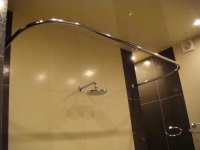
Curtain for the bath is a convenient and stylish accessory that allows you to divide the room into several functional zones, as well as reliably protect the floor from water splashes. Previously, a string was used to hang the curtain, but this option of attachment, which can not be called reliable and aesthetic, is now completely replaced by a rod for the curtain.

Choice of material
Rod for a curtain - it is more reliable and durable in comparison with the string holder, which is made of different materials:
- Plastic rods. They are the lightest and most affordable. The movement of the curtains on the rod made of plastic is almost silent, but this accessory also has significant disadvantages: the fast-wearing material is short-lived and changes color over time.
- Metal rods. They belong to a higher price category. Crossbars made of stainless chrome steel and aluminum are more durable, resistant to corrosion, moisture, temperature changes, and have a more presentable appearance.
- Combination boomsmade of metal with enamel or plastic coating. It is the best option that combines the reliability of metal products and practicality of plastic.
- Crossbars made of wood. Despite the fact that wooden bars are impregnated with a moisture-resistant composition, this subject of the interior refers to the exclusive and is used in designs where beauty tends to prevail over functionality.

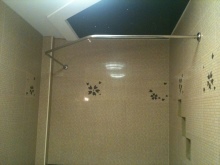
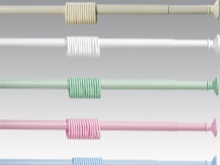
Regardless of the material of the product, the curtain rod needs periodic care. If you regularly wipe the construction from moisture and monitor the appearance of corrosion, this piece of interior will serve you long and worthy.
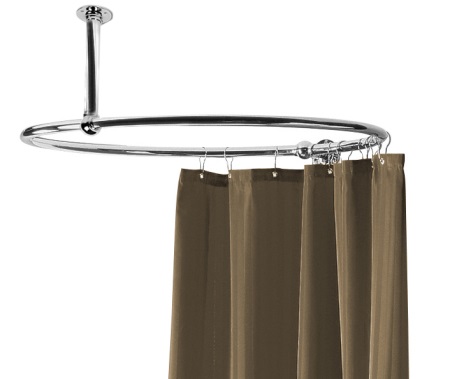
Choosing the shape
To perform its functions well, the curtain rod should ideally follow the lines of the bathroom. In terms of shape, curtain rods are divided into standard straight and angular designs and special non-standard, made to order.
Standard - straight
Standard straight rod comes in a fixed length or telescopic. It is an uncomplicated, versatile in attachment and therefore popular design, which rests with both ends on the walls without any corners or bends.
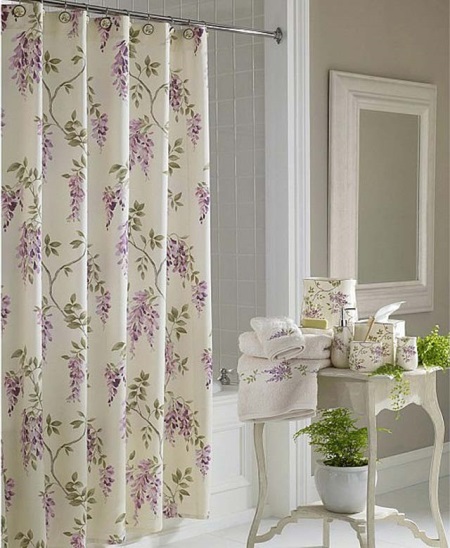
Angled or curved crossbar
A corner or arch bar is the optimal modification for shower stalls or trays located near a wall. The arc bar has a defined rounding radius and is shaped like a semicircle.
The corner bar can consist of one or more corners.
The most common are:
- The L-shaped model, which has one right angle;
- a more complex U-shaped bar, used in cases where the bathtub is adjacent to one wall.
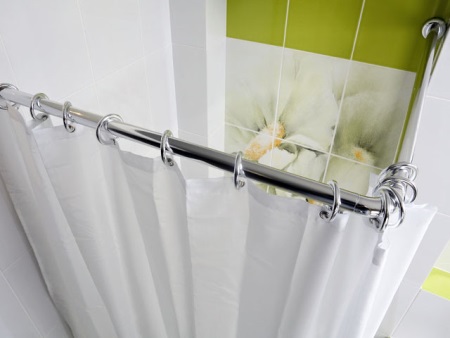
Special non-standard
Special non-standard bars are usually made to order for the individual shape of the bathtub and can have very different lines: wavy, arched, asymmetrical, in the form of a trapezoid or hexagon, and also consist of several parts and levels.
The imagination of designers and architects has no limits and allows you to use in the process of creating such bars atypical materials for such a curtain rod: wood or glass.
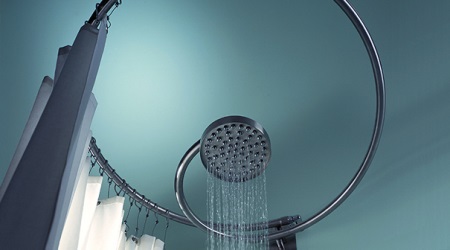
Choose a mount for the curtains should be based on the style and design of accessories and sanitary ware, as well as the overall design style of the bathroom.
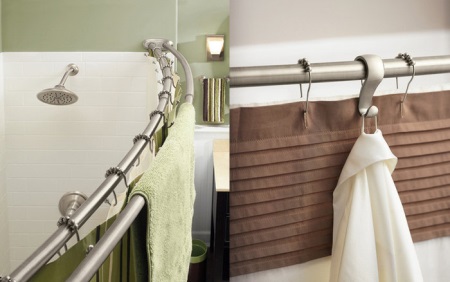
Classification by design
Among the variety of interior items for the arrangement of comfort in the bathroom, you can meet many models of curtain holders, different from each other by material, shape, style and color solution.
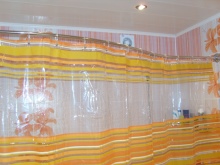
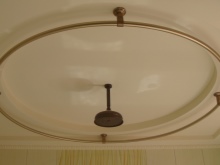
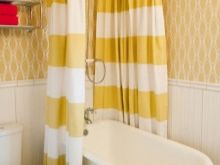
Let's consider which bar will best match the design and functionality of your interior:
- For classic, wall-mounted bathtubs, a straight or curvilinear bar with a slight curve will do.
- Corner and curvilinear bathtubs as well as trays are draped with L- and U-shaped corner cornices.
- In large rooms, where the bathing area is often arranged in the middle, the bathtub is closed closed closed (round, rectangular, curved) bars.
When choosing a curtain rod for the curtain should also be considered with the allowable load: so the plastic rod will be in harmony with a light vinyl curtain, and metal - with a solid cloth curtain.
Rings for the curtain in the bathroom
Rings for the curtain in the bathroom are selected depending on the material of the crossbar. Metal rings are stronger than plastic rings, but they can run tight when they move on the ledge, causing premature wear on the mount and making a loud ringing noise. Rings made of plastic move more quietly, but they lose their appearance much faster than metal ones. Experts consider the most practical material for the production of rings for the boom is metal with a polymer coating. It combines the reliability of metal holders and the quietness of plastic ones.
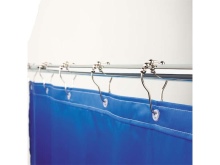
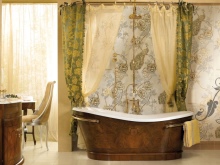
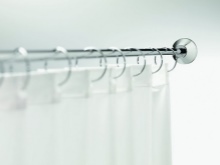
What is the best way to fix the curtain rod
Holder for the curtain can be fixed independently, but before mounting it, it is worth carefully determining the place of attachment. There are the following installation options:
- Wall mount.
- Mounting to the ceiling.

For angular bars in the area of the bend, it is recommended to implement a backing mount to the ceiling surface, as the support of the curved rod to the two opposite walls will not be enough. In addition, if the bathroom has suspended ceilings, it is not possible to mount the elements to the ceiling surface.
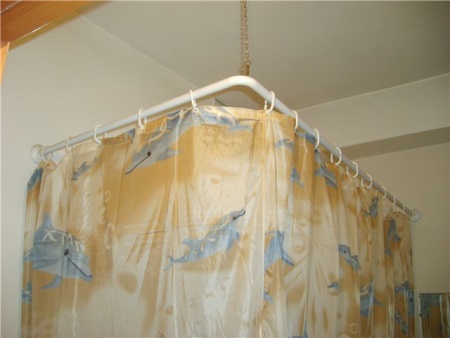
For maximum protection of the bathroom floor surface from splashing and moisture, it is important to hang the rod so that the curtains cover the bathtub by about 15 cm. Also, do not mount the rod close to the ceiling surface - it is worth to step back from it at least 10-15 cm.
Installation of telescopic rod
Telescopic rod is a type of curtain rod, consisting of two tubes of larger and smaller diameter inserted into each other, recommended for light curtains of polyethylene and vinyl. The advantage of the telescopic rod is that it has no dimensions, because its size varies due to the prefabricated construction.
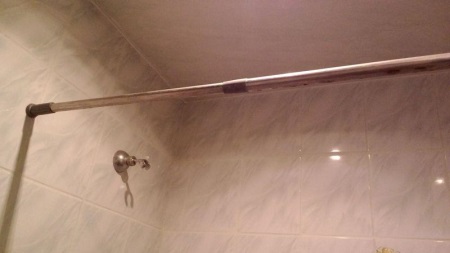
The telescopic rod is easy to attach and remove, and it is impossible to deface the wall with it.
Installation of the telescopic rod does not require drilling into the wall and consists of only three steps:
- Selecting the required height - It is sufficient that the curtain "overlaps" the surface of the bathtub by 15 cm;
- Selecting the required length;
- Fixing and fixing the ledge.
For fixing the telescopic rod simply extend the crossbar to a length that is 1-2 cm greater than the distance between the walls, and using the stepladder insert the ledge between the wall surfaces. Due to the work of the internal spring bar will act as a spacer. This type of attachment can hardly be called reliable, since under strong physical impact, the bar can easily displace or fall, and is not recommended for installation in bathrooms used by children.
Installation by means of fasteners
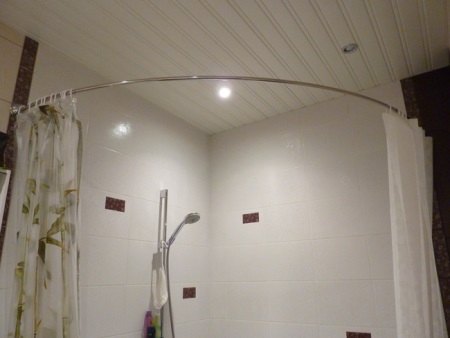
Installing a curtain rod with a wall or ceiling mount is much more difficult. To do this, you need to have tools such as a drill, a punch or concrete drill, a tile drill, a Phillips screwdriver and a pencil.
The sequence of attaching the rod to the wall is as follows:
- Place the curtain rod to the edge of the bathtub and mark the points of contact with the wall surfaces;
- Using a level, raise these points 150-160 cm up, taking into account the length of the curtain. If the area of attachment of the rung coincides with the tile joint, move it some distance to the side to avoid complete damage to the tiles.
- Take out the end pieces supplied with the holder and, aligning them with the wall, mark the points where the holes need to be drilled.
- Make the holes of the required diameter to a depth of about 40 mm and carefully hammer the dowels into them so that a length of about 1 mm is left free. When installing the bar in the walls of plasterboard, special dowels, popularly called "butterflies" are used.
- Align the fasteners with the wall and secure them with screws;
- Unscrew the clamping screw, put on the decorative caps and insert the crossbar into the end elements.
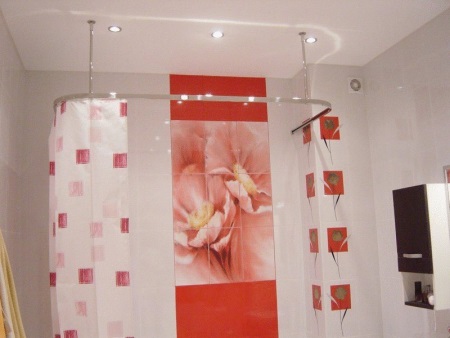
If you need to mount the rod to glass or porcelain tile, you will need a diamond drill.





I have a classic bath. But still want a rod with a slight bend to make it more interesting.